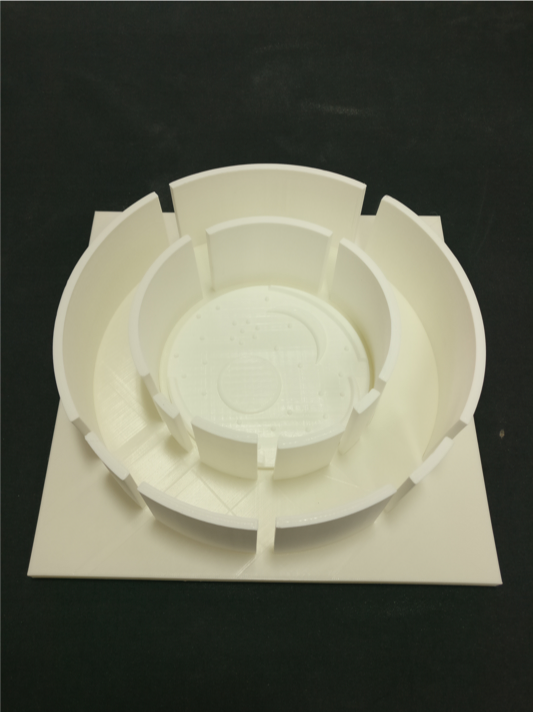
Technichal Specifications
How to use this exercise?
Shaping and understanding time: timing of people in prehistory by example goseck circle and Nebra sky disk.
Number of pieces of this exercise
19
General description
On a plate of four parts each14 cm x 14 cm (height 1cm), which are to be connected to each other, the palisades of the goseck circle are plugged.
The palisades should have a thickness of 0.5 cm and a height of 7 cm. Between the two palisade rings the distance is 4 cm.
Into the inner-palisade-circle the model of the Nebra sky disk has to be placed (no plug connection). The Nebra sky disc should have a diameter of 14 cm.
Additional Material
Models used:
License Info
Attribution 4.0 International (CC BY 4.0) https://creativecommons.org/licenses/by/4.0/You are free to:
Share — copy and redistribute the material in any medium or format
Adapt — remix, transform, and build upon the material
for any purpose, even commercially.
Under the following terms:
Attribution — You must give appropriate credit, provide a link to the license, and indicate if changes were made. You may do so in any reasonable manner, but not in any way that suggests the licensor endorses you or your use.
No additional restrictions — You may not apply legal terms or technological measures that legally restrict others from doing anything the license permits.
Learning Specifications
How can the model be used in class?
Unit “time” – 225 minutes
- 45 minutes: time definition, intervals, phrases “Zeit”
- 45 minutes: measure time, sense of time
- 45 minutes: How did people of prehistory determines time without modern aids (watches, calenders, …)?
All mankind learned to condense and prepare food, they were no longer predominantly engaged in the absorption and digestion of the same. An understanding of planning and the opportunity to learn from mistakes has developed – an understanding of the future and the past. In most languages spoken today, the times are in conjugable verbs and adverbial determinations. Very few nations do not know such language regulations today. In order to ensure survival, the people of the early days had to develop methods to determine the migration from summer to winter pastures in nomadism or later sowing and harvesting at sedentary. Neolithic circular can be found in central Germany as far as Austria, although not all of them were excavated and archaeologically reconstructed. With the Nebra Sky Disc, binding to a fixed location was no longer necessary, as it could be read in a relatively large area using stars and thus enabled people to determine important times.
Natural catastrophes and other unforeseeable changes in the weather could, however, undermine planning. In terms of the curriculum, students can learn that the handling of time in every sense, mankind still engaged today.
Building the model.
Using a light source to simulate the sun during the year and determine time. - 45 minutes: time usefulness in religion (for example: concept of time in the Koran, in the Bible, in the Talmud, …)
- 45 minutes: What do I take time for? How do we divide our time?
What benefits can its use have?
- Concrete knowledge about time determination of yore people including practical implementation.
- The 3D model increases understanding through experimental possibilities.
- Clearness can be integrated into the units without any financial and planning effort.
- Old models / findings can be experienced using a new technique (3D printing).
- Curiosity is awakened.
Can it be used in other subjects?
History: from nomadism to sedentariness; Development of the knowledge from the fixed Neolithic circular plant to the flexible Nebra sky disc
Astronomy / Astrophysics: Solar Cycle / Pleiades
Geography / Geology: Central Germany, soil condition
meteorology: weather conditions, growth phases
